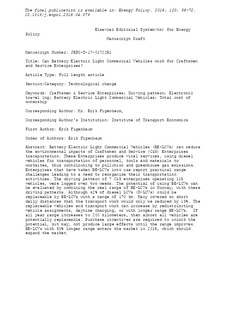| dc.contributor.author | Figenbaum, Erik | |
| dc.coverage.spatial | Norway | nb_NO |
| dc.date.accessioned | 2019-06-27T08:00:41Z | |
| dc.date.available | 2019-06-27T08:00:41Z | |
| dc.date.created | 2018-05-22T08:26:09Z | |
| dc.date.issued | 2018-05-17 | |
| dc.identifier.citation | Energy Policy. 2018, 120 58-72. | nb_NO |
| dc.identifier.issn | 0301-4215 | |
| dc.identifier.uri | http://hdl.handle.net/11250/2602464 | |
| dc.description.abstract | Battery Electric Light Commercial Vehicles (BE-LCVs) can reduce the environmental impacts of Craftsmen and Service (C&S) Enterprises transportation. These Enterprises produce vital services, using diesel vehicles for transportation of personnel, tools and materials to worksites, thus contributing to pollution and greenhouse gas emissions. Enterprises that have taken BE-LCVs into use report practical range challenges leading to a need to reorganize their transportation activities. The driving pattern of 7 C&S enterprises operating 115 vehicles, were logged over two weeks. The potential of using BE-LCVs can be evaluated by combining the real range of BE-LCVs in Norway, with these driving patterns. Although 42% of diesel LCVs (D-LCVs) could be replaceable by BE-LCVs with a range of 170 km. Many covered so short daily distances that the transport work would only be reduced by 13%. The replaceable vehicles and transport work can increase by redistributing vehicle assignments, daytime charging, or with longer range BE-LCVs. If all year range increases to 200 km, then almost all vehicles are potentially replaceable. Purchase incentives are required to unlock the potential, but may, not produce large effects until the range improves. BE-LCVs with 50% longer range enters the market in 2018, which should expand the market. | nb_NO |
| dc.description.abstract | Can battery electric light commercial vehicles work for craftsmen and service enterprises? | nb_NO |
| dc.language.iso | eng | nb_NO |
| dc.publisher | Elsevier | nb_NO |
| dc.rights | Attribution-NonCommercial-NoDerivatives 4.0 Internasjonal | * |
| dc.rights.uri | http://creativecommons.org/licenses/by-nc-nd/4.0/deed.no | * |
| dc.title | Can battery electric light commercial vehicles work for craftsmen and service enterprises? | nb_NO |
| dc.title.alternative | Can battery electric light commercial vehicles work for craftsmen and service enterprises? | nb_NO |
| dc.type | Journal article | nb_NO |
| dc.type | Peer reviewed | nb_NO |
| dc.rights.holder | © 2018 The Author(s). Published by Elsevier Ltd. | nb_NO |
| dc.description.version | submittedVersion | nb_NO |
| cristin.unitcode | 7482,2,4,0 | |
| cristin.unitname | Miljø og klima | |
| cristin.ispublished | true | |
| cristin.fulltext | preprint | |
| cristin.qualitycode | 1 | |
| dc.identifier.doi | 10.1016/j.enpol.2018.04.076 | |
| dc.identifier.cristin | 1585791 | |
| dc.source.journal | Energy Policy | nb_NO |
| dc.source.volume | 120 | nb_NO |
| dc.source.issue | September | nb_NO |
| dc.source.pagenumber | 58-72 | nb_NO |
| dc.relation.project | Norges forskningsråd: 227068 | nb_NO |
| dc.relation.project | Norges forskningsråd: 257653 | nb_NO |

